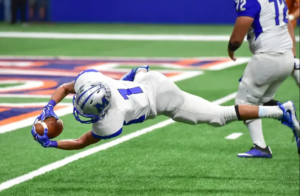Understanding Compartment Syndrome in Athletes: A Serious Threat to Football Players
September 12 2024
Compartment syndrome is a condition that all athletes, especially football players, need to be aware of due to its potentially life-threatening consequences. This condition occurs when pressure within the muscles builds to dangerous levels, reducing blood flow and cutting off oxygen and nutrients from the muscles and nerves.

While compartment syndrome can happen to anyone, athletes are particularly vulnerable due to the intense physical demands they place on their bodies. Football players, in particular, are at risk because of the high-impact nature of the sport, which can lead to traumatic injuries.
What is Compartment Syndrome?
Compartment syndrome occurs when the tissue pressure in a specific muscle area, known as a “compartment,” rises above normal. Compartments are groups of muscles, blood vessels, and nerves enclosed by tough membranes (fascia). When swelling or bleeding occurs in these compartments, it creates intense pressure that can’t be relieved. If untreated, this pressure can cause permanent damage to muscles, nerves, and blood flow.
There are two main types of compartment syndrome:
– Acute Compartment Syndrome: This type is more common in football players and athletes. It usually follows a severe injury, such as a bone fracture, a hard hit, or a significant contusion.
– Chronic (Exertional) Compartment Syndrome: This occurs due to repetitive activities like running or cycling, and it’s common in athletes who push their bodies to extreme limits.
Why Are Football Players at Risk?
Football players face constant risk of impact-related injuries. High-speed collisions, tackles, and sudden changes in direction are all part of the game, and these can lead to trauma in the legs, feet, and arms—areas commonly affected by compartment syndrome.
In some cases, an athlete may experience severe bruising or even fractures from a tackle or fall. These injuries, particularly if not identified and treated immediately, can lead to internal bleeding and swelling, creating pressure in the muscle compartments. If not relieved quickly, this pressure can stop blood flow, leading to muscle death and, in severe cases, limb loss.
Recognizing the Symptoms
Identifying compartment syndrome early is crucial. In acute cases, symptoms usually appear within a few hours of an injury. Athletes should watch for:
– Severe, persistent pain that doesn’t go away with rest or pain medication
– Swelling and tightness in the affected limb
– Numbness or tingling in the leg, foot, or hand
– Weakness or difficulty moving the limb
– Loss of sensation or a cold feeling in the area
If an athlete feels severe pain after an injury or experiences these symptoms, immediate medical attention is necessary.
Prevention for Football Players
While it’s difficult to prevent all injuries in football, athletes can take steps to minimize the risk of compartment syndrome:
1. Wear proper protective gear to avoid severe impacts.
2. Stay conditioned and flexible to reduce the likelihood of injury.
3. Monitor overuse injuries, especially if there is persistent pain or swelling after practices or games.
4. Seek immediate medical attention for any significant injury, especially one that causes extreme pain or swelling.
5. Listen to your body. Never push through pain that feels unusual or severe.
Compartment Syndrome: A Serious Condition Not to Ignore
For football players and other athletes, understanding the risks and symptoms of compartment syndrome is vital. This condition can progress quickly, and delaying treatment may lead to serious, long-term consequences, including permanent muscle damage or even amputation. However, with prompt recognition and care, most athletes can recover fully and return to their sport.
If you or someone you know suspects they have compartment syndrome or has experienced a traumatic injury that could lead to it, contact Family Foot & Leg Center immediately. Our team of specialists is ready to provide expert care to ensure the best possible recovery.
Serving Southwest Florida Since 2005, Family Foot & Leg Center has 9 convenient locations throughout Collier, Lee, Charlotte, and Sarasota Counties. Offering pediatric to geriatric family care: Ingrown Toenails, Heel Pain, Bunions, Foot / Ankle Arthritis Pain, Plantar Fasciitis, Foot / Ankle Surgery, Custom Orthotics, and Diabetic Wound Care. In office X-rays, ultrasounds, and minor surgical suite exam rooms. Practice powered by EMR and advanced technologies. Home of the Lam Minimally Invasive No-Scar Bunion Surgery! Come Discover Why Patients Love Our 5-Star Foot & Ankle Care! Same Day Appointments! Easy Online Appointment Scheduling.

 Fax: (239) 692-9436
Fax: (239) 692-9436 Tel: 239-430-3668
Tel: 239-430-3668

